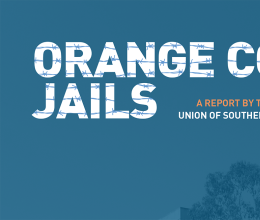By Michael Cummings, New York Civil Liberties Union at 12:54pm
In New York’s prisons, people caught with too many postage stamps in their cells can land a stint in extreme isolation – the harshest possible punishment in the state prison system.
Extreme isolation – locking one or two people in a tiny cell for 23 hours a day under conditions commonly understood as solitary confinement – should never be a disciplinary tool of first resort. In fact, the cruel and ineffective practice should be eliminated all together.
The New York Civil Liberties Union just concluded an intensive, year-long study of New York’s use of extreme isolation, described in a report released this week, Boxed In: The True Cost of Extreme Isolation in New York’s Prisons.
Over the course of our investigation, we communicated with more than a hundred people who have spent significant amounts of time in extreme isolation. We interviewed prisoners’ family members and corrections staff and reviewed thousands of pages of official records obtained through open records laws. (A companion website excerpts of prisoners’ letters about life in extreme isolation, a library of DOCCS data and records, statistical analyses and a video featuring the voices of family members whose loved ones have been held in extreme isolation.)
We found that the state’s use of extreme isolation endangers prisoners and corrections staff. It undermines prison safety and, ultimately, makes our communities less safe.
Individuals in extreme isolation spend at least 23 hours a day in a cell about the size of a parking spot. They are deprived of all meaningful human contact or mental stimulation. “Recreation” is an hour in an outdoor cage like a kennel. Phone calls are prohibited. Meals arrive through a slot in the door. There is no access to educational or vocational programs or rehabilitative services.
As punishment for simple misbehavior, such as not promptly returning a food tray, people can be further deprived of basic necessities like nourishing food, showers or toilet paper.
About a third of the roughly 4,500 New York prisoners in extreme isolation are “double-celled" with another prisoner. Double-celled prisoner are locked up together — showering and defecating in front of each other —for weeks, months and even years on end. This practice commonly results in violence and often can be more psychologically debilitating than standard solitary.
Ceaseless isolation and deprivation causes grave psychological and emotional harm, including severe depression, rage and uncontrollable impulses. Corrections staff receive few resources to safely manage individuals buckling under the stress of extreme isolation or its effects once they return to the general prison population.
Last year, the state doled out more than 13,500 extreme isolation sentences – about one for every four people incarcerated. Just over 8 percent of New York’s prison population is in isolation at any given time, the vast majority for non-violent offense, such as selling chewing tobacco, testing positive for marijuana, and yes, for having too many postage stamps, which are considered contraband. Only 16 percent of isolation sentences from 2007 to 2011 were for assault or weapons.
What happens in our prisons can seem remote, but the use of extreme isolation affects all New Yorkers. Each year, 25,000 people are released from New York's prisons. Thousands will have spent time in extreme isolation. About 2,000 people are released directly from isolation to the streets. They receive no transitional programming before their release to support a productive return to society.
Our report lays out sensible reforms that the state Department of Corrections and Community Supervision could initiate immediately to make our prisons and communities safer. First, DOCCS should establish clear and objective standards to ensure prisoners are separated only when necessary, under the least restrictive conditions and for the shortest time possible. Then DOCCS should audit the current population in extreme isolation, identify people who do not belong there and return those prisoners to the general prison population.
These reforms would bring an end to a disastrous and unnecessary decades-long human rights crisis in our prisons, and put New York where it belongs: at the vanguard of smart and effective criminal justice reforms that both improve public safety and reaffirm our state’s commitment to human dignity.
http://www.aclu.org/blog/prisoners-rights/life-box-inhumane-and-unsafe-extreme-isolation-new-yorks-prisons
Life in a box: inhumane and unsafe extreme isolation in New York’s prisons
Related content
Federal Appeals Court Requires Immigration Authorities to Consider...
October 3, 2017ACLU: Immigrant Detainees in Orange County Illegally Denied...
September 13, 2017Advocates Applaud Governor Brown and Chief Justice's Commitment to...
August 25, 2017ACLU SoCal Statement on OC Sheriff Sandra Hutchens’s Retirement
June 27, 2017ACLU Report Finds Inhuman, Violent Conditions in Orange County Jails
June 27, 2017